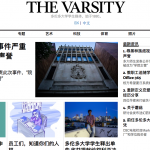Can a Phoenix rise from the ashes of Canada’s news media?
Starting a paid-circulation print newspaper in 2017 is bold enough to earn attention in the Canadian mediasphere. The CBC, Toronto Star, Globe and Mail and National Post have all run warm pieces on the launch of the small, crowdfunded West End Phoenix, billed as a hyper-local community newspaper serving that part of Toronto.
The West End Phoenix even got a mention in a Maclean’s article by former Conservative MP and cabinet minister Chris Alexander. He cited the Phoenix, The Tyee and Ku’ku’kwes News as examples of “smart new media outlets” that can help move the conversation (and perhaps a politician’s unwanted association) away from more divisive outlets like The Rebel. The Tyee has been around for 14 years, and Ku’ku’kwes News has been covering Indigenous news in Atlantic Canada for more than two years. It’s quite a coup for the Phoenix to make Alexander’s list before a single issue had been published. The first issue of the Phoenix will be launched tonight.
It’s helped that the Phoenix is taken flight under the guidance of Dave Bidini, author of books and eclectic columns (most recently in the National Post) covering Canadiana, music and hockey, among other topics, and a member of Toronto-based band the Rheostatics.
The attention and support has been impressive considering Bidini has been tight-lipped about the monthly newspaper. More than half of the $300,000 target was raised before the first issue has been printed.
The West End Phoenix website and much of the media coverage suggests that Bidini saw much to be admired in community newspaper The Yellowkniferwhile working on a book in the Northwest Territories capital.
The Tyee asked Bidini about the crowdfunding success while providing few specifics about the Phoenix.
“There haven’t even been teasers really,” he said. “We’ve come to this point by really selling an idea. There were suggestions of whether we should mete out some visuals or some prose but we’ve done none of that. It’s just been an illumination of talking to people about it.”
“It’s been more like a timeshare than anything,” he said, laughing.
Bidini couldn’t say if Chris Alexander knew more about the newspaper he was touting as an important new voice. But he has known Alexander for a long time.
“Chris and I differ hugely politically,” Bidini said. “I’ve had some great times with him, too — he’s a big fan of the band. He’s funny. You know, there is no accounting for taste in a lot of ways. I found that with the band. Music really translates across those political dimensions. I do think with newspapers, no matter what your political leanings are, you can kind of get behind the fact that we need writing and we need art and we need journalism.”
Perhaps that desire for journalism — and Bidini’s enthusiasm — explains the support of high-profile financial patrons and subscribers for the new monthly broadsheet.
The Canlit contingent includes Margaret Atwood and author Yann Martel though neither are Toronto west-enders. Atwood is an Annex resident (and recently mused she may leave the city during a Twitter battle about condo NIMBYism in her neighbourhood) and Yann Martel is based in Saskatoon.
Supporters didn’t need a lot of details before writing a cheque, Bidini said.
“They didn’t want to know much really — they could see it, I think, quite clearly, not just for themselves but others,” he said.
“Remarkably, people have been able to make the leap… people like us are gravitating and swinging back to the idea of the newspaper at this time. That’s one of the reasons we thought it was a good time to launch. It’s one of those things that was once so familiar to us that now approaches us as being sort of strange and different because it’s been out of our greater lives for a long time.”
These backers and paid subscribers (1,200 of the targeted 5,000 so far) are the kind of supporters desperately needed by established Canadian newspapers shrinking, shuttering and merging in recent years. With them went what many consider valuable local services — reporting on city councils, school issues, crime reporting, for instance.
Bidini and others have held up hyperlocal community news publications as a ray of hope in the gloomy newspaper world. It is a space where cumbersome and skeletal wire-reliant newspapers owned by merger-made entities can’t so easily compete.
“We have no competitors,” said Bidini. “Totally in a lane of our own. Lonely, solitude. [Toronto weekly alternative] Now magazine covers the city, reviews and listings, they do occasional large features, but it’s where to find what is happening that week. Bigger newspapers don’t really do local.”
And Bidini is happy to try to occupy this space without treading into more competitive markets.
“Competition, if there is any, is like Metroland community newspapers but they’re not even really newspapers,” he said, referring to a chain of community newspapers owned by the Torstar Corporation, which also owns the Toronto Star. “With all of the other print and media groups, we’ve only sensed support really from them honestly — like the Star has written about [us] and we’ve been in the Post and stuff. I wouldn’t want to be on the scale of those traditional print entities because, look, right now we’re delivering the paper. Myself and 35 volunteering. I’d love to have 20,000 subscribers if they all lived on the same street — that would be awesome!”
It’s not about growing big, Bidini said, pointing to his membership in the Rheostatics. The band, which recently came out of retirement, never had big hits but have a cult following, especially among musicians.
“In terms of how big it gets, how popular it gets, I’m not really interested in that — it comes down to pedigree. I’ve been in a really strange band for many years and we’ve never really cared too much about whether we were a popular concern.”
According to readership statistics, Bidini faces some challenges but with some hints of hope. Free, ad-supported community newspapers are actually up in circulation to 18.1 million from 12.7 million in 2007 in Canada. But paid circulation — the segment the West End Phoenix is chasing — is down significantly, from 1.1 million to 717,000 over the same period.
Bidini and his team have offered a few hints about the content and form of the Phoenix. He told the CBC the paper will provide “that feeling you get when you’re wandering home one night and you find yourself up an alley you haven’t travelled through before.”
Melanie Morassutti, the startup’s deputy editor — a former Globe and Maileditor and Bidini’s sister-in-law — told Niemanlab that the West End Phoenixwill be “taking time-honoured community newspaper conventions and amplifying them to the max: want ads, crime roundups, pet of the month.”
Asked what amplifying conventions means, Bidini said, “It’s playing with conventions, but also respecting them, of the community newspaper.”
“It’s not a hipster’s bible, right. We have to be grounded in the kind of newspaper that appeals to as many people as we can in the community.”
When asked if the newspaper would have beats or sections such as city council coverage, Bidini said not for now — it would be an evolving format.
“We have a big piece in our first issue in which there are city councillors involved and we’ve quoted them. I would like to have a beat like that but I don’t think we can do that as a monthly, honestly.”
Bidini acknowledges that the challenges of media saturation, particularly in a downtown urban setting, present a specific kind of hurdle for the monthly print publication.
“Because contemporary digital media are right on what’s happening, we sort of have to go into the dustbins for things that are left that people haven’t gone into to pull up the deep roots.”
Still, Bidini said, the Phoenix will aim to fill at least some of the gaps in community coverage created as legacy media shrink.
“We will touch on those areas — housing, school, crime. We’ll make sure they are stories that are a little bit deeper and not as obvious and can be told at any time.”
The Phoenix is also focused on bringing more diversity to the public discussion, Bidini said.
“It’s not going to be a bunch of white dudes with fancy beards,” said the bearded Bidini. “We will aspire to be inclusive and to have Indigenous voices. Three or four pieces in the first issue are about Indigenous communities in the West End.”
“Our community is made up of people from everywhere and we hope they can find themselves in here somehow.”
Bidini said he sought advice from people familiar with the landscape of diversity in the West End communities, which range from the rapidly gentrifying Parkdale to posh Bloor West Village. The paper’s board and advisory council includes Laas Turnbull, founder of the defunct Toronto weekly The Grid, media consultant Ali Rahnema, and J-Source managing editor H.G. Watson.
But will the new paper help reverse the trend of shrinking newsrooms?
Bidini said the paper is a “main-ish” gig for two of the five employees.
“Everyone is getting paid, all the writers are getting paid, all the staff are getting paid — go figure. Support has been so strong out the gate from subscribers and patrons and readers that we’ve been able to actually pay people, which is amazing and ridiculous. Now it’s just about shovelling coal, keeping that locomotive on the track.”
If the Phoenix reaches its $300,000 crowdfunding goal and attracts even half the hoped-for 5,000 subscribers, it will have about $440,000 to spend — about $37,000 per issue. (Subscriptions cost $56.50 for West Enders and $100 for mail delivery.) It’s relying on other support — office space at the hip Gladstone Hotel, volunteer deliverers, business patrons — to keep costs low.
But is the crowdfunded model sustainable? And can it be replicated in less affluent and more media-starved communities without the power of celebrity support?
Bidini said he hopes the Phoenix won’t be a one-year experiment and will become part of the community.
“Those are our intentions,” he said. “It has to be good, it has to be reliably good. We have to grow our readership, the soulful bond between newspaper and reader has to be established. We have to be smart about it how we put it together economically, financially, how we operate. If we have a strong year then maybe that means we can have a second year.”
Bidini acknowledged the challenges.
“We don’t have enormous backers, we aren’t a corporate entity, we’re ad-free. So it’s challenging in those respects, but the community has stood up for it so we have to deliver.”
And he meant it literally. The first issue will be mailed and delivered by Bidini and 35 volunteers in the next week, and would-be media startups country-wide will be watching what happens next.
Even days before the launch, Bidini caught himself before giving away any details about the first issue of the Phoenix.
“Well, we do have… well, I don’t think so, I’m careful — I do want it to be a surprise.”
This story was originally published on The Tyee, and is republished here with the editor’s permission. J-Source’s managing editor H.G. Watson is a volunteer on the advisory board for the West End Phoenix. She was in no way involved in the commissioning, writing or editing of this story.
Bryan Carney is director of web production at The Tyee.



